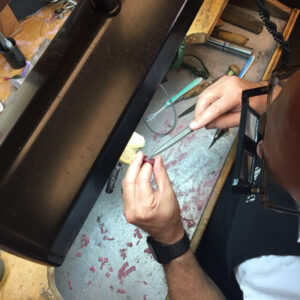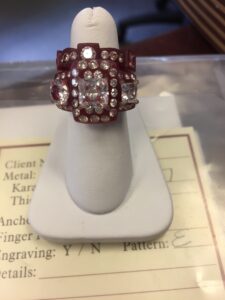Lost-Wax Casting for Custom Jewelry
Lost-wax casting is a 6,000-year-old metal-forming method that’s used to create intricate designs for jewelry, art, engineering and product manufacturing, and even dentistry. This longstanding creative technique takes years to master and is employed by jewelry craftspeople around the world who create highly detailed, elaborate designs. And it is one of the best ways to create custom jewelry pieces. If you’re considering working with a jeweler to create a custom piece, understanding the process of lost-wax casting can illuminate all of the design possibilities.
What Is Lost-Wax Casting?
In the simplest terms, lost-wax casting — also called investment casting and cire perdue — is the process of making a metal object from a wax model. It’s a highly versatile technique and allows jewelers to use a variety of metals, including gold, silver, bronze, brass, copper, platinum, and aluminum.
History of Lost-Wax Jewelry Casting
Historians trace this tradition back 6,000 years to the Indus Valley in South Asia, where the oldest-known object created with lost-wax casting, an amulet, was discovered. The technique was used around the world to make scepters, furniture elements, and sculptures, and historians have found these objects across multiple continents.
In the 18th century, in order to keep up with the demands of growing industries, the lost-wax casting tradition gave way to piece molding. Though the lost-wax casting technique decreased in popularity for some time, it was never completely forgotten. Now, there are many modern applications for lost-wax casting, from the medical field to engineering. Lost-wax cast jewelry making has remained one of the most popular applications because the method accurately reproduces intricate detail and design in metal.
The Lost-Wax Casting Process
The lost-wax process can vary slightly across industries; however, the same general steps apply when creating any lost-wax casting mold.
1. Developing a Wax Model
Lost-wax casting begins with the creation of a model, which an artisan carves by hand. Even at this early stage in the process, the artisan creates and refines the model to include any intricate details that will be part of the finished product. Though a time-consuming and labor-intensive process, the lost-wax technique allows for a level of detail that is difficult to replicate with any other method. Once the model is created, the designer inspects it for flaws and then presents it to the client. The client can then provide feedback and alter the design before the model is turned into the mold that will form the final product.
Several types of specialty wax may be used for this casting method; however, microcrystalline wax is often the most suitable option. It is pliable, slightly sticky, and easy to work with due to its medium to soft consistency. While paraffin wax may be used to cast molds, it is better suited as an additive to harden existing wax models. Jewelers still need to have some knowledge about other specialty waxes, including their melting points, as they can use them for specific purposes such as carving, modeling, or patching.

2. Creating a Wax Mold for Lost-Wax Jewelry Casting
Once the model design is approved, it is then attached to a sprue, a tube-like form that allows the molten metal to funnel into the mold. Then, the jeweler pours investment or high-grade plaster around the model to create a casting. A vacuum is then used to remove any air bubbles from the plaster to ensure the quality of the casting and produce a perfect mold.

3. Pouring the Metal
Once the casting is dried and then hardened in a kiln, the wax is removed to create a cavity in the shape of the model’s design. This process is called “burnout” and includes melting the wax down so that it can flow out of the casting. The molten metal is then poured into the cavity left behind by the melted wax. Once the metal is set, the jeweler carefully cuts away the investment to reveal the perfectly shaped design, which will still be attached to the sprue.
4. Finishing the Ring
Once the ring is removed from the sprue, the jeweler can then add gemstones such as diamonds, and then finish and polish the ring. Depending on the client’s desired look, the polishing process could yield a matte finish or a shiny finish on the metal.

Applications of Lost-Wax Casting With Digital Technologies
Lost-wax casting was first used to produce fine jewelry, and the technique, though less common, is still preferred among skilled, specialty jewelers. Modern inventions like technology and 3D printers allow for a smoother workflow, and talented artisans combine these techniques with hand carving to create more intricate and delicate details on custom jewelry designs.
Lost-Wax Casting Jewelry Design at JPratt Designs
At JPratt Designs, we use state-of-the-art CAD software to develop a concept and then create a lost-wax casting that clients can view and try on before confirming their custom design. We set gemstones in this model to give an accurate impression of the finished product. This process allows clients to express concerns and enables us to make any adjustments before setting diamonds and stones in the finished product.
With more than 30 years of experience creating fine jewelry for our clients, you can trust our artisans to create a custom design that you’ll love for years to come. Contact us today and schedule your appointment with our team of experts.
